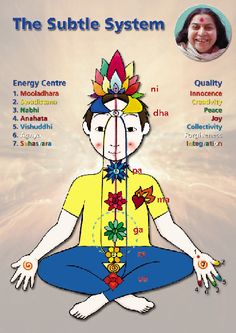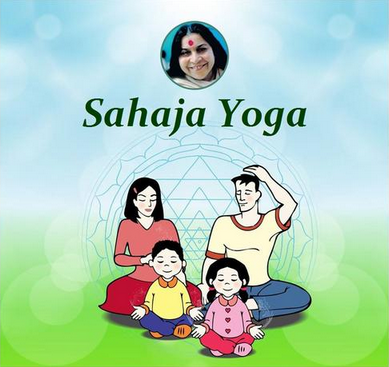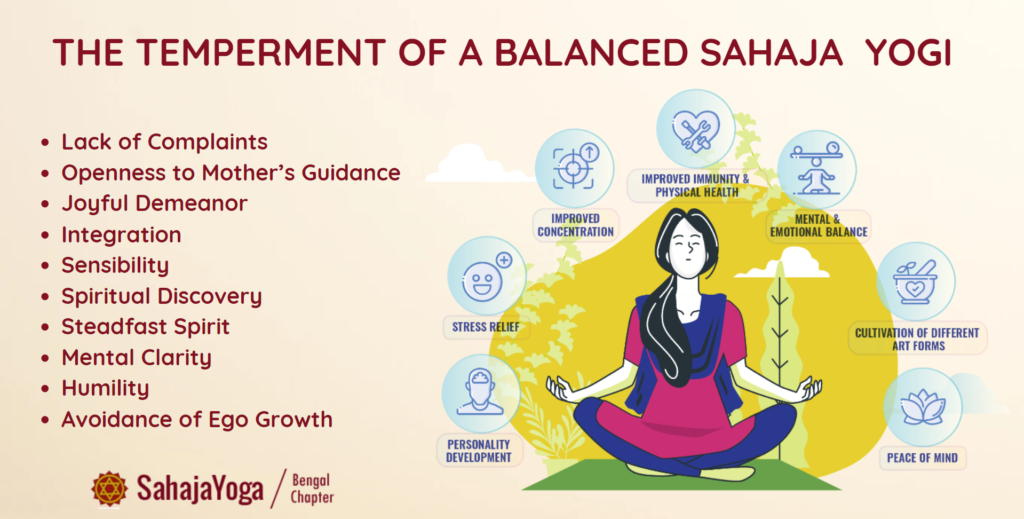Is Sahaja Yoga the practice of yoga or meditation?
Actually, Sahaja Yoga involves both yoga and meditation. While many current Western forms of yoga largely involve physical stretching, postures or exercises, Sahaja Yoga does not. Sahaja Yoga is yoga in the truest, most literal sense of the word — union (with the all-pervading power of the Universe). Without this union or yoga, the state of meditation cannot be achieved. For all practical purposes, Sahaja Yoga can be viewed entirely as a practice of meditation. Meditation is the means to achieve various stages of yoga.

Do I need to bring any equipment (e.g., a mat or “yoga apparel”) to practice Sahaja Yoga?
No, classes involve meditation only. The practice of Sahaja Yoga does not require specific poses, such as sitting cross-legged on the floor. You’re free to sit on a chair in a normal relaxed position, and, of course, to wear whatever you like.
Do I need to register for attending a Sahaja Yoga session?
Generally speaking, no. We welcome walk-ins. Occasionally, however, we may conduct special programs or events for which seating capacity is limited, in which case, prior reservations may be necessary.
Will Sahaja Yoga cost me anything?
No. Sahaja Yoga offers a non-commercial form of meditation. All weekly meditation meetings or classes are completely free. All techniques and knowledge are offered by experienced instructors free of charge. Advanced stages of the practice could include seminars or workshops, for which you might incur the costs of attending the event (e.g., food accommodations, etc.).
How are you able to offer sessions at no charge — what’s the catch?
There’s no catch! We’re able to conduct our programs through funds received from charitable donations. We’re not a commercial enterprise. We’re a volunteer, not-for-profit organization with instructors whose desire to donate their time is borne out of a desire to spread peace in the world. We believe that the knowledge of meditation and spirituality should be freely available to everyone; it is as natural as the air we breathe. We are all born with the Kundalini energy inside us and its awakening and spiritual truth is our birthright, thus it cannot and should not be “bought” or “paid for.” We believe that true spiritual meditation should be free.

How long will it take to learn Sahaja Yoga?
It really depends on the state of your subtle energy system, the amount of effort you devote to the practice, and the strength of your desire for personal and spiritual growth. But it is reasonable to expect that, within a few weeks, you can achieve the typical Sahaja Yoga experience of being able to experience the cool breeze, feel your Kundalini energy and being able to work on your chakras. Within a few months, you could progress to a point where Sahaja Yoga becomes a permanent part of your lifestyle, if you so desire.
How does Sahaja Yoga compare with other forms of meditation?
Sahaja Yoga can be both the practice of meditation and the pursuit of spirituality, while most other forms of meditation focus on temporary or short-term benefits of stress relief and, in some cases, long-term health benefits. While these kinds of benefits can be easily obtained from Sahaja Yoga, the longer-term benefits include more permanent, positive trait (rather than just “state”) changes in your life, enhanced well-being, improved relationships and a resilient, dynamic, balanced and peaceful personality.
Further, all of this is achieved using the power of the Kundalini energy, a vital force in not just achieving thoughtless awareness relatively effortlessly but also aiding your spiritual growth. The thoughtless awareness is established on a plane of consciousness higher than the mental plane, another unique difference when compared to other forms of meditation. And practicing Sahaja Yoga is truly and genuinely free.
Are there any prerequisites for practicing Sahaja Yoga?
No, everyone is welcome to simply start practicing Sahaja Yoga. We welcome children and adults alike. Sahaja Yoga is practiced in multiple countries and by people of different ages, genders, religions and cultures. Children are likely to take to Sahaja Yoga much more easily due to their inherent innocence.
Is Sahaja Yoga a religion? How does spirituality differ from religion?
Spirituality is the realization of your Spirit or Inner Self and discovering God within you through a personal, independent journey that you control entirely with guidance from someone who knows a lot more about it.
Religions are man-made structures comprised of specific methods for discovering God. They tend to involve doctrines and rules that one must follow in order to be “accepted” into that group or fellowship body. All religions were originally intended to allow you to directly experience your Spirit, but today, most of them have different objectives that focus on the means and methods, rather than the outcome itself.
Sahaja Yoga can be viewed as the personal, inner and subtle religion within you, the religion of your Spirit. Yet, Sahaja Yoga is not an organized religion. No doctrines, dogmas, or prerequisites are necessary for practicing Sahaja. And yes, you can continue to practice your current religion while practicing Sahaja Yoga, if you wish even as you discover your inner spiritual religion.
Can I continue to practice other types of yoga or meditation or exercises while practicing Sahaja Yoga?
Certainly, you can continue to practice any form of physical fitness exercises. While it is okay to practice other types of meditation while you practice Sahaja Yoga, the best results can only be obtained through a focused practice of Sahaja Yoga. This helps you isolate and understand the depth and power of the Sahaja experience clearly. With any spiritual meditation experience, It’s important to be able to verify your results along the way and pinpoint what’s working for you.
In some rare cases, there may be conflicts with other forms of yogic meditation, especially other forms of Kundalini yoga. No harm or side effects will result even in this case but you may take a much longer time for your subtle energy system to come back to balance and for your Kundalini to start working inside it in the way that Sahaja Yoga was designed.
How is Sahaja Yoga different from Mindfulness meditation or other Buddhist meditation techniques?
Sahaja Yoga allows you to achieve thoughtless awareness on a plane of consciousness that transcends the ordinary mental and physical planes of consciousness, whereas most other meditation techniques employ concentrative methods of eliminating thoughts (such as focusing on an object) while still leaving one’s attention at the mental plane of consciousness. Every form of meditation has a purpose and benefits, so your choice may depend on what you’re looking for. Sahaja Yoga is a powerful capsule of thoughtless awareness and the pursuit of spirituality.
Is accumulating advanced knowledge of Sahaja Yoga the key to receiving its benefits?
No. Merely accumulating spiritual knowledge won’t make you spiritual unless your knowledge is accompanied by — or even preceded by — the actual connection of your Kundalini energy to the divine energy. For thousands of years, human beings have tried to master spirituality by voraciously reading books and becoming more knowledgeable. But Sahaja Yoga is a living process, the actualization of spirituality. It’s about the experience. One can have just a little bit of knowledge about the subtle energy system and still be highly spiritual. Sahaja Yoga is the becoming of the Spirit and becoming a subtler personality, not becoming a knowledge-only “expert.”
Can I choose to just meditate at home after the initial few sessions?
Yes, you can attend as few or as many sessions as you like. However, long-term Sahaja practitioners will tell you that Sahaja Yoga is most effective over the longer term when practiced collectively. But yes, you may still experience significant benefits through regular meditation at home.
What is the role of Shri Mataji in the practice of Sahaja Yoga?
Shri Mataji founded Sahaja Yoga in 1970. She developed the technique through which anyone’s energy could be raised, spontaneously and with near effortlessness, through a sequence of simple steps. Her goal was to make this spiritual connection accessible to everyone. The concept of recognizing spiritual gurus originated in the East and is, in general, less common in Western culture.
Shri Mataji is recognized and admired by many practitioners in both the West and East alike as any degree or combination of spiritual guru, teacher, mentor or simply a special person with a special ability to influence the subtle Kundalini energy system of human beings. She is viewed and accepted as a spiritual Mother by many. Your perspective of Shri Mataji and her relevance to your personal practice of Sahaja Yoga can only be decided by you through a process of experimentation and self-discovery. It would be impossible to generalize such subtle attitudes and feelings towards spiritual gurus. They’re meant to be developed within each individual.
Does Sahaja Yoga provide enlightenment?
In order to understand this, one needs to understand what enlightenment truly means. While the connection to the divine and realization of the Self can be an entry point to achieving enlightenment, true enlightenment involves the transformation of the person to a subtler being who demonstrates the qualities of an enlightened soul in daily life. But yes, Sahaja Yoga offers a very good chance at providing enlightenment over the long term for practitioners who continue to practice.

Can Sahaja Yoga be used as a therapy for diseases and disorders?
Yes, there is significant research showing that Sahaja Yoga can be an effective treatment for many different diseases and disorders, both as a standalone therapy and in conjunction with other modern clinical therapies. Many people have practiced Sahaja Yoga primarily for the purpose of improving their health and well-being, but there’s a lot more to a Sahaja Yoga practice than just the health benefits. While treatments or “cures” are not the primary goal for most Sahaja Yoga practitioners, the practice automatically provides certain coincidental health benefits. Sahaja Yoga is not to be viewed exclusively as a cure or remedy for any disease or disorder, at best, only as an adjunct therapy.
Do you advocate vegetarianism when practicing Sahaja Yoga?
Absolutely not. Sahaja Yoga does not take a stance on vegetarianism, veganism, or other such rigid dietary doctrines. Vegetarianism has no impact on the practice of Sahaja Yoga, or on the quality of the benefits you receive. However, Sahaja Yoga allows you to determine whether the food you eat at any time can have a positive impact on your subtle energy system. For instance, it is advisable to reduce proteins or caffeine in your diet if your right side nadi or energy channel is lacking the flow of the Kundalini energy. These foods might in fact make the problem worse and prevent you from getting into balance.
I’ve stopped meditating. Can I restart my practice of Sahaja Yoga?
Absolutely. It is normal for people to become irregular since we are always busy with our lives. The Kundalini energy remains active as long as we practice our meditation, sometimes even irregularly. You can always go through the affirmation techniques and get back on track. Even if you stop practicing Sahaja Yoga, there is no harm that will come to you, your Kundalini will simply go back to its dormant state.
Is Sahaja Yoga good for children?
Definitely. Children are filled with innocence and take to Sahaja Yoga. You might have some difficulty in getting them to sit down and meditate, but eventually they’ll be able to take to it quite easily.

I’m taking anti-depressants. Should I stop taking them?
We do not recommend stopping your medication under any circumstances and you should follow your doctor’s advice. Sahaja Yoga’s core focus is not cure, however, many people have found effective solutions in dealing with depression when meditating through Sahaja Yoga. Many have given up anti-depressants over time when they felt they no longer needed it. You are the best judge of how to make Sahaja Yoga work for you and be sure to consult to your doctor too if you’re showing positive improvements in your situation with your meditation.
I am having problems sleeping well at night. Can Sahaja Yoga help?
Absolutely, try doing your foot soaking regularly and before going to bed and you’ll see a huge improvement.
Why am I seeing colors when I meditate? Is this normal?
This is not typical when practicing Sahaja Yoga but there’s no reason to get worried. This is a temporary phenomenon for those of us who might have our attention in the supra conscious region. This happens when we’re worried about the future all the time and when we’re thinking and planning excessively. Sometimes very angry people can also become violent or aggressive and in such extreme cases the attention is said to shift entire into the supra conscious and even beyond into the collective supra conscious. In the subtle energy system, our right side is governed by the sun and the future. We exercise our right side powers and energies in performing all our actions, but when this goes out of balance this is known as becoming “right sided”. Sometimes right sided people can see colors during their meditation. The solution is to balance our attention through thoughtless awareness and try and remain in a state that is neither too worried about the future or the past and we are neither overactive or lethargic.
Does Sahaja Yoga help see the third eye?
First, the concept of being able to see the third eye is misunderstood by many. The third eye, which is spoken about in ancient scriptures is located in the Agnya chakra, which is placed on the crossing of the optic chiasma. And this subtle center acts through the eyes and at the back of the head where we have some protrusion. This is the physical side of this center. This is the third eye.
So that we have two eyes with which we see and then there’s a third eye, which is a subtler eye through which we can see. We do not see the third eye itself, only through it, just as we see through a window and look at the outside world. When we’re looking at the window, we cannot see what’s outside it. The opening of the Agnya chakra does indeed help open the third eye within us.
Why do I feel vibrations only on one hand or on some fingers and not on others?
We feel vibrations on our fingers because the nerve endings corresponding to our chakras are located on the tip of our fingers on our hands (also on our feet). If specific chakras have not been opened fully or at all due to blockages, then we may not feel the vibrations on the specific fingers.
Likewise if the Kundalini energy is not flowing through the left or right energy channels due to excessive depletion of energy that happens due to excessive mental, physical and emotional activity, then we may not feel vibrations on our left or right hand entirely. Clearing out the chakras and channels and bringing ourselves back in balance causes the vibrations also to begin to flow through all our fingers and hands.
In fact, this irregularity or difference in energy flow can be used as a diagnostic tool to assess the state of our chakras and clear ourselves all the time.
Do you see any connection between science and spirituality?
Sahaja
Yoga can be the ultimate bridge between science and spirituality.
Plenty of clinical research has demonstrated the impact of the practice
of Sahaja Yoga on neural networks and proved through fMRI images. And
since the fundamentals of Sahaja Yoga are completely spiritual, one can
begin to explore the scientific truths behind spirituality and try to
establish a correlation. Another significant correlation is the
functioning of our nervous system. The knowledge of Sahaja Yoga
correlates the nadis or energy channels to our nervous system. The left
and right nadis correspond to our sympathetic nervous system while the
central channel or Sushumna nadi corresponds to our parasympathetic. The
rising of the Kundalini through the central channel thus automatically
regulates the relaxation response attributed to the parasympathetic
nervous system. We draw the energies from our left and right side
channels all the time to perform our actions and this corresponds
exactly to sympathetic nervous system activity.
There are many other
concepts that establish a strong scientific correlation to the spiritual
practice of meditation in Sahaja Yoga and this is only the beginning
for the human race to try and establish the bridge between science and
spirituality and in fact discover that science may actually be a
creation of the divine and a small subset of it. And that there’s hardly
any conflict between it and spirituality.

Can you describe the Sahaja Yoga technique of meditation?
First of all, Sahaja Yoga is not a technique nor is the meditation that is practiced in Sahaja Yoga. Yoga is the union of the Kundalini energy with the all-pervading power. This results in a state of meditation that is established on a higher plane of consciousness. So, technically, we fall or enter into the state of meditation. Sahaja Yoga does not use any techniques or methods of mind control, concentration and even the thoughtless awareness is mostly established spontaneously by the power of the Kundalini energy.
Of course, there are a few tips and tricks involved in improving thoughtless awareness, but these do not necessarily constitute techniques of meditation. Likewise, the raising of the Kundalini energy by the practitioner may be thought of as a technique, yet it cannot really be called a technique of meditation, it only aids the connection (yoga) and ushers us into the state of meditation.
Perhaps the most important fact that confirms that Sahaja Yoga is not a technique based practice, is that the Kundalini can also rise just using our attention and in other ways such as music or through affirmations. There is no single method or technique involved. In addition, Sahaja Yoga works directly from our hearts and the strength of our desire, no technique can influence those.
I’m having trouble getting thoughtless during meditation. What can I do?
Here are a few techniques if you’re relatively new to Sahaja Yoga. Try to watch your thoughts by separating out your attention from the thoughts. Allow the thoughts to pass by without reacting to them by saying to yourself “Not this” again and again. You could also try to watch your breathing – in and out. Music can be used for meditation, so having your attention on the music can greatly help reduce thoughts. You can use the music links on this site for this purpose.
How many times a day should I meditate, how long and when?
This
is a difficult question to answer as each person needs to meditate
according to what works for him/her. Typically meditating once in the
morning after waking and once at night before going to bed is
recommended. 15 – 20 mins might be optimal although it is hard to typify
this. The quality of thoughtless awareness is more important. Many
times, you may find that you need more time to settle in and stabilize
your attention.
Of particular importance and benefit is early morning
meditation, especially at dawn. However, there’s no need to be rigid
about it or if you miss your meditation sometimes. Attending a
collective meditation session once in a week is highly recommended.
How can I clear a chakra?
First, lets see what clearing a chakra means and why it’s necessary. Our chakras can develop obstacles that obstruct the flow of the Kundalini energy. These may develop due to imbalances in our attention, our behavior, thoughts and emotions as well as from places we visit or sometimes, the food we eat. Chakras frequently need cleansing and this is done in a few different ways.
Rotate your right hand in a
clockwise direction around the chakra by placing your palm a few inches
away from the spot where the chakra is located with the palm facing
inward.
You could also use footsoaking techniques to get rid of the
obstacles. Try sitting on the ground to clear some of the lower chakras
and especially the Mooladhara chakra. Refer to the information on the
specific chakras on this site to find out reasons for the catches and
how to clear.

How does Sahaja Yoga’s thoughtless awareness differ from other meditation techniques?
The biggest difference is the plane of consciousness on which thoughtless awareness is established. Sahaja Yoga helps achieve a new plane of consciousness by virtue of the rise of the Kundalini energy and its passing beyond the Agnya chakra. To give some examples, the states of deep sleep, waking and being awake are different states of consciousness of our existence. Yet, when we’re awake our mind is always filled with thoughts and our awareness is filled with them. The state of thoughtless awareness is established on a new plane of awareness of consciousness that goes beyond the mental plane. In this state, we’re perceiving our own Kundalini energy, our Spirit and the divine energy and feeling the vibrations. Thoughtless awareness is really established on this plane of consciousness. In many other forms of meditation, mental silence is established by trying to separate out thoughts within the mental plane. Not that this is not effective in any way, it has its own benefits. But in Sahaja Yoga, the power of the Kundalini energy helps achieve thoughtless awareness relatively spontaneously over time than having to struggle in the mental plane.




